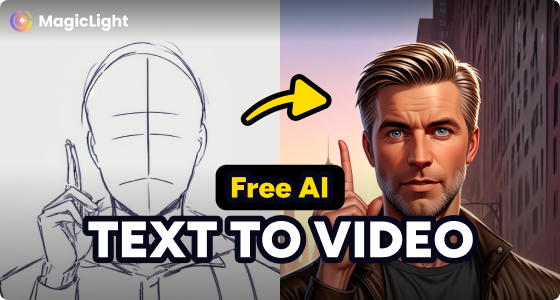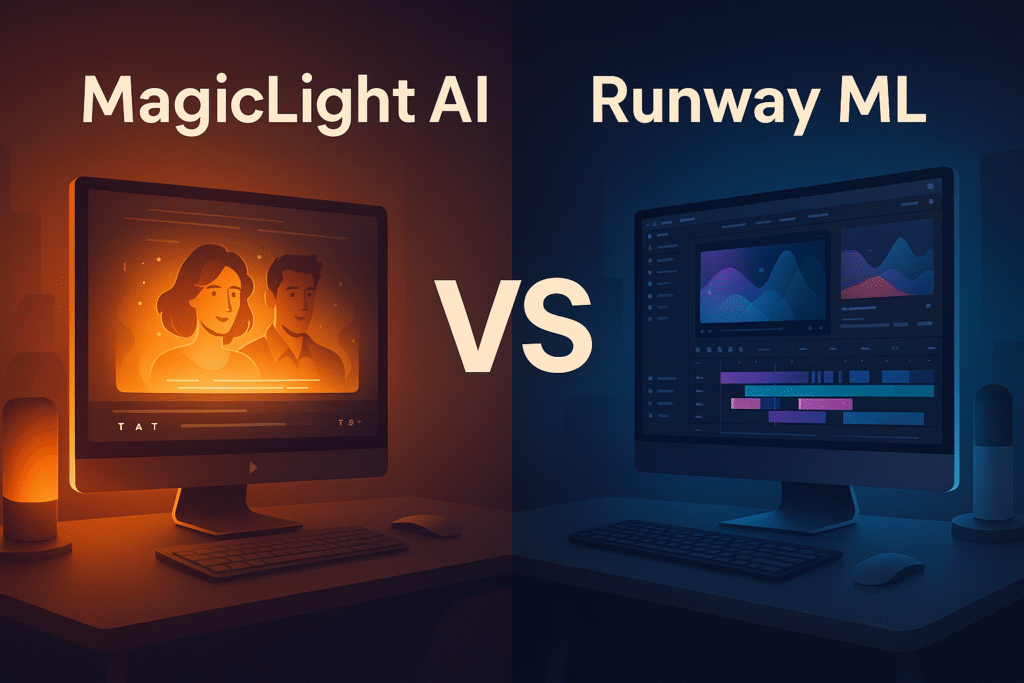The rise of AI in video creation is revolutionizing how visual content gets made. No longer do creators need expensive equipment or months of editing; with the right tools, scripts can be turned into polished videos in minutes.
Two standout platforms in this space today are MagicLight AI and Runway ML. In this article, we’ll dig deep into their features, performance, pricing, and ideal use-cases. By the end, you’ll know which is better suited for your content goals in 2025.
On this Content
2. What Is MagicLight AI?
MagicLight AI is a text-to-video (and text → image → video) platform designed to transform written ideas or stories into animated videos with consistent characters, dynamic voices, lighting, and cinematics.
Key Features
- Long-form video generation: Users can generate videos up to 30 minutes from a single prompt.
- Consistent characters & lip-sync: Upload a photo to help the system maintain consistent character appearance across scenes; voice and lip movement are synchronized.
- Scene & lighting control: You can adjust angles, transitions, lighting cues, and style in a built-in editor.
- Hybrid modes: It supports text-to-video, image-to-video, and animation-like approaches (e.g. applying visual styles)
Use Cases
- Storytelling: Convert scripts, novels, or tales into animated videos.
- Marketing: Video ads, product narrative pieces.
- Content creation: YouTube shorts, social media visuals, animated explainers.
- Education: Lesson modules or animated lessons turned from text.
Pros & Cons
Pros:
- Capable of relatively long videos (tens of minutes) in one pass.
- Character coherence and lip sync minimize the “jarring cut” feeling.
- Intuitive controls for lighting, style, and transitions.
Cons:
- Probably less matured in professional-level editing tools (color grading, frame-by-frame control).
- Dependence on prompt quality; complex scenes may require tweaking.
- Pricing details less transparent in public (few reports).
3. What Is Runway ML?
Runway ML, particularly its Gen-2 and broader AI suite, is a more established platform for generative video, image editing, and creative workflows. It’s known in the creative and AI community for offering powerful tools that transcend just text-to-video.
Key Features
- Gen-2 multimodal video generation: Create new video content from text, images, or a combination thereof.
- Editing & compositing tools: Green screen / background removal, inpainting, object masking, motion brush, video layer editing.
- Integration & export options: Sequence exports, ProRes, PNG frames, high-resolution outputs under higher tiers.
- Credit-based generation: Uses a “credit” system for generation. Each video or task consumes credits.
Use Cases
- Visual effects and post-production: Artists incorporate AI into video pipelines.
- Pro-level creatives: Filmmakers, directors experimenting with AI scenes or concept visuals.
- Content marketers: Advanced spot editing, overlays, and AI effects.
- Prototyping and ideation: Quickly visualizing concepts.
Pros & Cons
Pros:
- Rich set of editing tools beyond simple prompt-to-video.
- Strong export and integration flexibility.
- Transparent credits model and known performance benchmarks.
Cons:
- The credit model can become expensive for heavy use.
- Some features are locked under higher pricing tiers.
- Steeper learning curve than more “all-in-one” tools.
4. MagicLight AI vs Runway ML: Feature Comparison
| Feature | MagicLight AI | Runway ML |
|---|---|---|
| Video Length / Scope | Up to ~30 minutes in one prompt | Typically shorter video segments; complex scenes may require stitching and editing |
| Prompt Modes / Input | Text → Image → Video; supports animation styles | Text, image, video mixed modes (Gen-2) |
| Editing Capabilities | Basic scene transitions, lighting tweaks | Advanced tools: masking, inpainting, green screen, timeline editing |
| Character Consistency / Lip-Sync | Strong consistency, automatic voice sync | May need manual refinement for ideal results |
| Rendering Speed & Quality | Optimized for narrative flow, visual polish | Variable based on resolution and credits; high quality possible |
| Pricing / Cost Model | Less public detail; presumably usage-based or subscription | Transparent credit-based pricing with tiers (Free, Standard, Pro, Unlimited) |
| Best Use Focus | Story-driven video, long-form content, animations | Creative editing, combining AI with traditional post-production |
5. Performance & Output Quality
Realism & Motion
Runway’s Gen-2 and video synthesis models tend to produce solid motion, realistic transitions, and smoother frame interpolation in many tests. MagicLight’s strength is in narrative cohesion, especially when dealing with dialogue, character scenes, and visual consistency across scenes.
Lighting & Visual Style
MagicLight emphasizes cinematic lighting, scene coherence, and stylistic mood. On the other hand, Runway gives more control to creators: you can override or mask elements, blend styles, or composite external assets.
Handling Complex Scenes & Backgrounds
Runway’s masking, inpainting, and green-screen tools can help salvage or polish tricky scenes. MagicLight may struggle in highly detailed or crowded scenes unless the prompt is carefully tuned.
Render Times & Throughput
For many users, MagicLight’s all-in-one approach offers faster end-to-end creation, while in Runway, splitting scenes and layering effects may extend total time. But in exchange, Runway gives more fine-tuning control.
6. Pricing & Subscription Comparison
Runway ML Pricing (as of 2025)
- Free: Limited credits, watermark/quality restrictions.
- Standard ($12/month/user): ~625 credits monthly, full access to Gen-4, 1080p exports, faster queues.
- Pro ($28/month/user): ~2,250 credits, 4K exports, priority rendering.
- Unlimited ($76/month/user): Unlimited video generation under Explore mode; credits still apply for non-video tasks.
- Enterprise: Custom enterprise features such as SSO, dedicated support, custom credit allotments.
Each video or model run consumes credits (e.g. Gen-4 Turbo: 5 credits per second)
Unused credits expire monthly; credits are shared across workspace editors.
MagicLight AI Pricing (public data limited)
MagicLight’s site and app mention:
- Free / trial: Users get a free 6-minute video with HD export, plus 300 free creation credits for watermark-free videos.
- Beyond that, they likely operate a credit or subscription model, but exact public pricing tiers aren’t clearly posted.
- Trustpilot descriptions suggest capabilities to generate up to 50 minutes, but that may be promotional or future-oriented.
Cost Comparison Takeaway:
Runway is more transparent and testable — you know how many credits a 10-second clip might cost. MagicLight’s pricing is more opaque. If you produce many videos, Runway’s credit model might give you predictable budgeting; if your needs are lighter or more narrative-focused, MagicLight’s all-in-one promise may trump the unknown cost.
7. Ease of Use & Interface
- MagicLight AI is oriented for creators who want one-click-to-video flow. The learning curve is relatively light.
- Runway ML has more tools and options, which means more to learn. But it’s structured for creative professionals accustomed to visual editors.
- MagicLight simplifies character setup, scene transitions, and voice sync so that less manual intervention is required.
- In Runway, tasks like masking, blending, or layering require some familiarity with visual editing, but you gain precision in return.
8. Ideal Users: Who Should Use Which?
| Use Case | Best Pick | Why |
|---|---|---|
| Story-focused video / long narrative | MagicLight AI | Strong narrative coherence, character consistency, minimal manual edits |
| Creative or VFX-heavy editing | Runway ML | Advanced tools like masking, compositing, layering |
| Beginners or non-editors | MagicLight AI | Simplified workflow and automated pipelines |
| Professional film or post-production | Runway ML | Control, export flexibility, integration into pipelines |
| Marketing or short social clips | Either (depending on volume) | MagicLight for speed, Runway for effects customization |
If your goal is to produce narrative content (children’s stories, animated sequences) with minimal fuss, MagicLight is likely the faster route. If you want full control over every frame or want to mix AI with hand edits, Runway is more suitable.

9. Pros & Cons Summary
MagicLight AI
- Pros: Fast, narrative-friendly, character consistency, low barrier to entry
- Cons: Less transparent pricing, fewer professional editing controls
Runway ML
- Pros: Robust editor, wide toolset, export options, mature platform
- Cons: Cost can scale quickly, steeper learning curve
10. Final Verdict
There’s no one-size-fits-all winner — which tool is better depends on your goals, volume, and required level of control:
- Choose MagicLight AI if you want to generate story-driven videos quickly without diving into manual editing.
- Choose Runway ML if you want full control, fine editing, and the ability to blend AI with classical post-production workflows.
For many creators, the ideal path might even be using both: start the video in MagicLight, export scenes, then polish in Runway (or vice versa) depending on needs.
As AI video tech evolves, we’ll likely see more hybrid tools that combine narrative ease and editing sophistication. In 2025, the best tool is the one that helps you bring your vision to life most efficiently.
11. FAQs
- Is MagicLight AI free?
Yes — new users can create a 6-minute HD video and receive 300 free credits for watermark-free exports. - Does Runway ML support 4K export?
Yes, but only on higher-tier plans (Pro and above). - Which tool is faster for short social clips?
MagicLight often wins for speed in straightforward scenes; Runway’s overhead can slow you if you’re editing heavily. - Can both platforms generate human motion or dialogue scenes?
Yes, but MagicLight focuses more on character consistency and dialogue across scenes; Runway may require manual adjustments for ideal lip sync or movement. - Which is better for professionals or agencies?
Runway ML offers more control, integrations, and export options — making it more suited for professional workflows.

